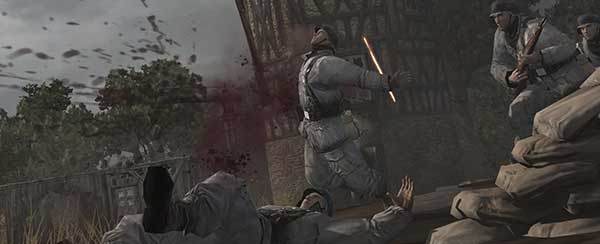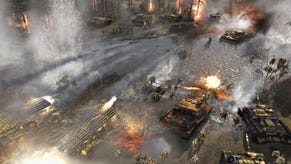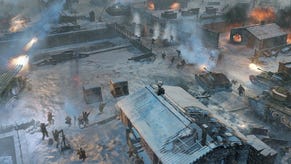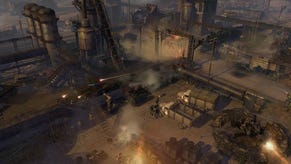Eastern Promises: Company Of Heroes 2 Interview
The big chill
After being shown a demo of Company of Heroes 2 at Relic's headquarters, we took the opportunity to sit down with game director Quinn Duffy, producer Greg Wilson and senior gameplay designer Matthew Berger, to find out more about what they have planned for the sequel. Then we talked about history, finding heroism in horror and brutality, and how too much balance can harm a game's other qualities.
RPS: Last night I was preparing questions and I didn’t know anything about the setting. I was hoping it would be the Eastern Front. You didn’t just make this game of me though, right? Why did you go for that setting?
Duffy: There are a bunch of reasons. The story itself, the setting, the epic nature of it. The mystery of it as well, especially the Western perspective on that, which has been really skewed. We don’t really understand. So the exploration of that has been an important part of the process. We’ve kept in contact with our fans through the forums. There are still hundreds of thousands of people playing the game every month. But from day one, from when Company of Heroes shipped, people have been saying “you have to do the Eastern Front next”. As time has gone on, that’s never gone away. People want the Eastern Front.
Now that people aren’t talking about an expansion, they want the real deal. A full sequel.
RPS: Do you follow the modding community? There was a decent Eastern Front mod.
Duffy: Yeah, they did a great job.
Wilson: We actually fixed a bug for them in our final patch.
RPS: There was patch, I think in May, for Company of Heroes 1...
Wilson: Yeah, that was a huge one.
RPS: A lot of the balance tweaks seem to come from community feedback but what about the expansions? Were they a way of experimenting with different stories and play styles? Tales of Valour was very different. Did you see that as a way of looking for ideas for the sequel?
Duffy: I think when we looked at those things, the idea of a sequel was JUST an idea. Tales of Valour was an opportunity for the team to experiment with some features, the more hero based ideas, a different way of telling stories.
All of that contributes to the pool of knowledge and experience in the team, those of us who have worked on the team in the past. It’s also a way of challenging ourselves, injecting different types of gameplay into the Company of Heroes experience.
But when we look back to a couple of years ago when we started work on Company of Heroes 2, we looked at the parts of the original that were still compelling to us. What we wanted to do was to take forward certain parts that we wanted to focus on. It was the core gameplay experience that we wanted to bring through.
When we talk about the sequel, in some ways it’s not new, we’re not taking the game in a completely radical direction, it’s a bunch of really cool new features and a lot more authentic. More environmental destruction, more tactical gameplay. That feels like a Company of Heroes sequel.
RPS: The new tactical additions, particularly the new line of sight, to me who knows nothing about the process of doing these things, making the AI work well with that sort of thing seems like it could be a big rod for your own backs. Quite the challenge!
Duffy: We don’t want to put any system in the game that the AI can’t use…
RPS: It seems that that happens a lot in strategy games.
Duffy: IT happened in the original Company of Heroes. There were abilities that the AI couldn’t or wouldn’t use, not properly or consistently. We put a lot more effort and focus on the AI, making it understand its role and the challenge it should offer to the player. It’s not about beating the player, it’s about offering them a fun experience. That’s a different way of looking at things.
RPS: There’s some similarity with the multiplayer. One thing that stood out that you said was that people still play the game together and tell stories about what happened. Less competitive and more experiential. That’s something that I always got from the first game’s campaigns as well. How important is it that your systems play into that?
Duffy: Critically. It’s amazing how many of our systems have nothing to do with game balance at all. They make our lives really hard because of some of that there is randomness.
Berger: Unlike other RTS games, you can’t look at a unit and work out that you do so much DPS and that unit has X health, so it will take so many shots to kill it. But, no! It could take that first shot to the face and also be crippled, or you could miss a few times, it could get to cover.So there is a lot of variance in the game and in the pacing and in the way the tactical depth works together. It makes it a deep game but also an approachable game where you have the time to react to the battlefield and make the decisions you need to make. Quinn, for example, is a slow, old person and would not be able to compete in a competitive RTS but in an environment like COH his knowledge of tactics and battlefields makes him a force to be reckoned with.
Duffy: Well, now he’s trying to be nice. I’m a mid quality player. For me it’s a sort of ‘what you see is what you get’. My expectation as someone who loves history and the military experience, I want these weapons to do what I expect them to do. I want these troops to react how I expect them to react. The systems that we use to build all of that are immense. We actually put more effort into how much our machine guns miss than to how they hit.
Berger: Because that’s not easy to do.
Duffy: You want to get that walking fire and shells hitting walls.
RPS: One of the attractive things about the game is how you see the aftermath of a battle.
Duffy: It creates an oddly beautiful mise en scene.
Berger: But it’s not just the obvious systems like that. It’s other things on the periphery of the game that impact on our core mechanics. So we have a unit set up that fires a certain way and another that fires a different way. It all balanced perfectly and it worked fine. But it actually impacted on our soundscape because the burst lengths were the same and it didn’t create the kind of audio variety you’d expect from a battle, so we had to work on the length of the burst, so we could maintain the balance of the unit but create a much more compelling sound space and therefore more compelling encounters.
Duffy: Much more variance in the battle and the intensity. It changes as you get up close and all that kind of stuff. When you reduce those tuning variables you just get BRRR BRRR and there’s no variety, we want something more like BRR RATATATA BRRRRRRRRR.
Berger: That’s a constant struggle on the team. Don’t focus on the balance. We’ll make the numbers work but you have to get the feel right first. It has to feel compelling, it has to feel like you’re in a battle.
RPS: In the demo you hear the battle in the background and a lot of the historical talk was about scale. How do you go about getting that scale across to people?
Duffy: That is part of it. We want cues in the background to remind them that they’re part of a bigger battle. There are things that will really help reinforce that scale that we talked about and it’s really important to portray that. The balance for us is not losing the tactical gameplay, not overwhelming the player.We’re not getting into thousands of units, it doesn’t make sense for the kind of game we are. We’re still Company Of Heroes.
RPS: It seems to go back to the storytelling as well. I think you said at one point actually, so I won’t pretend I was clever enough to think of this for myself, that you’re telling a story about individuals not ideologies. But then you have this overarching campaign story told by a war correspondent. Is that a method of telling the political story as well?
Duffy: Yes, definitely. It allows us to put him in places where a soldier wouldn’t have access. We had some really compelling characters in the first Company of Heroes, our company commanders. But they never see what Eisenhower or the joint chiefs have been talking about. They don’t have that level of exposure. When we have a character like our war correspondent we can introduce the challenge of those high level decisions and the impact of the ideology and the drive that pushes the front line troops around. Their life is about a single bullet but they are pushed and driven forward by the leaders and by ideologies. It’s important in a campaign to put that across.
RPS: One of the reasons that I think Normandy has been done so often is because it more naturally lends itself to a tale of heroism and valour. Or at least to a Western audience. How difficult is it to communicate the heroism on the Eastern Front.
Duffy: There’s a ruthless truth we want to convey. To be unflinching but still to find that. What makes, I think, heroism on the Eastern Front so compelling is that in many ways these guys were beset on all sides. The normal Soviet soldier is fighting the Germans, he’s struggling within the system he’s part of. Finding what motivated these guys to do what they did is…well, it’s the same on the Western side. That’s what I find so fascinating about the history. But on the eastern side, the privation they were faced with.
RPS: In that it was a fight for survival as much as victory at times?
Berger: When you drill down to the level that we operate at, which is closer to the individual, on either side you will always find those individuals who rose above and beyond. In the many many stories and books that we’ve read there are so many examples. I remember reading something about a famous female sniper, I forget her name. She would never get off the front line and she died doing her duty, saving other soldiers, constantly exposing herself to the enemy. There are countless examples like that on the Eastern Front and every other war as well. There are always these heroic figures who become larger than life. They fight for the people next to them, not necessarily for their country. They might fight with a red star on their uniform but that’s really not necessarily what they are fighting for.
Duffy: A great example of that was when we went to St Petersburg. We went to the Nevsky Bridgehead Museum where the Soviet forces had linked up finally and broken the siege of Leningrad. There was a soldier, I wish I could remember the name of the fellow, but he dove into the mouth of a German machine gun embrasure. He blocked the gun slit with his own body and obviously he won a posthumous award. You don’t do that for Lenin or Stalin. That’s to protect the people following you. You get that in every army.
RPS: And every war.
Berger: We ran into something similar when we did our first expansion for COH. Part of that was from the perspective of the Germans. Once again, you find the heroes are the people who want to save their friends not the people who want to serve the system.
RPS: But is it important for you to tell the story of the system as well?
Duffy: It provides context. You need some of the ‘whys’. Why did they fight? That level of introspection on the system is important.
Berger: It has an impact on the game. Order 227, for example. It takes a certain outlook on life to say ‘that’s it, we’re not moving back’.
Duffy: The Canadian army didn’t have something like that. The British army didn’t have something like that. The Soviets had executed thirteen thousand men in Stalingrad, just in Stalingrad. The Canadian army didn’t execute a single soldier for retreat or cowardice.
Berger: We like to quote Stalin, “In the Soviety army it takes more courage to retreat than to advance”.
RPS: Events like the retreat, shown in the demo, are they only scripted events to advance the plotting of the company that the player is with?
Duffy: We’re going to explore these things really heavily in the campaign. The scripted element we showed is to introduce the player to the concept, but some of the choices will be up to the player. It’s another tactical choices: when, if, can I retreat in this situation. The narrative of the campaign is the perfect avenue to explore this stuff. It’s safe there.
RPS: Going back to line of sight briefly. A word that came up again and again was ‘dynamic’. The changing battlefield. Is that for replayability as much as anything else? To let people play through again and find things go differently?
Duffy: I don’t know if it’s so much about that. Replayability naturally comes out of the destructibility of our environments and the fact that many times, a map can play completely differently given that a tank might decide to punch through a wall…
RPS: When you were playing through, machine guns were set up and a grenade went off and it seemed like it was supposed to blow a wall to bits. But it didn’t quite land close enough and it didn’t happen. We didn’t get the big moment!
Berger: Yeah, we ran through it a few times to prepare and we kind of wanted the wall to go but we can’t control completely where that grenade lands. Sometimes a tree goes up, sometimes it’s the wall. Sometimes nobody dies because they made it to the cover too fast.
RPS: Good. Otherwise you might as well have shown us a movie!
Berger: Exactly! The line of sight, the true sight system, brings things like that out a lot more in the encounters. You won’t know if there’s someone behind a hedge or not. Forests are great. I’ve been experimenting with forests. All of a sudden you can take your infantry through that space and their line of sight is completely limited and it’s too crowded to take in a vehicle.
RPS: Does it bring in unpredictability?
Berger: Not so much that. It extends the danger zone and it extends the fear of losing your troops. With some line of sight systems you can see behind everything and know what’s around. Now you can’t. It ties in well with our new audio because you can hear something sometimes but you don’t know exactly where it is. If a tank moves it gives itself away a little though. It extends the lack of knowledge.
Duffy: It makes certain weapons potentially more dangerous. Antitank guns for example, or machine guns that often rely on ambush. In a straight up gun fight, guys with an antitank gun against a tank, they can be out in the open trying to kill the crew with machine guns but that first shot is going to be all important. Through a gap in a wall or through a building.
RPS: The tension and the setting, of course, remind me a little of Red Orchestra – the setting obviously – but also the tension.
Duffy: It breeds attachment to your troops and that’s a huge part of what we want. Immersion. Making these soldiers feel more real. When we showed COH at E3 in 2006 I liked zooming in and show the soldiers’ fingers. When you see fingers on a guy and then you zoom back up to the God mode, all that detail still exists in your mind. That attachment becomes stronger to those characters, along with the way they move around and the way they talk.
The tension comes from the system but also from the presentation. You don’t know if you want to risk losing the little dudes. It goes back to Homeworld and what we learned there. It’s why a lot of our games have these flexible cameras. You can play from the default, but you get in and look at what we’re presenting, like in Homeworld the turrets traversing stuff, when you pull back you have such a huge picture in your mind. It gets your imagination moving more.
RPS: When you reduce war to flags being pushed around on a map it’s easy to forget what’s actually happening on the ground. Abstract horror was another phrase you used earlier. To get that across there has to be attachment and an understanding of fragility. You said the vehicles had to be like ‘vulnerable monsters’ as well.
Duffy: Systems have to support presentation and presentation has to support systems. That's the goal.
More to come, including how Homeworld defined Relic's approach to design.












